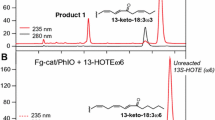Abstract
Mycobacterium vaccae strain JOB-5 cometabolized 2,4,6-trinitrotoluene (TNT) in the presence of propane as a carbon and energy source. Two novel oxidized metabolites, as well as several known reduced products, were generated during catabolism of TNT byM. vaccae. During the cometabolic process, there was transient production of a brown chromophore. This compound was identified as 4-amino-2,6-dinitrobenzoic acid. WhenM. vaccae was incubated with [14CTNT and propane, 50% of the added radiolabel was incorporated into the cellular lipid fraction. These results suggest that ring cleavage occurred prior to the incorporation of radiolabelled carbon into phosphatidyl-l-serine, phosphatidylethanolamine, cardiolipin, and other polar lipids.
Similar content being viewed by others
References
Beam HW, Perry JJ (1973) Cometabolism as a factor in microbial degradation of cycloparaffinic hydrocarbons. Arch Mikrobiol 91:87–90
Beardsmore AJ, Aperghis PNG, Quayle JR (1982) Characterization of the assimilatory and dissimilatory pathways of carbon metabolism during growth ofMethylophilus methylotrophus on methanol. J Gen Microbiol 128:1423–1439
Bligh EG, Dyer WJ (1959) A rapid method of total lipid extraction and purification. Can J Biochem Physiol 37:911–917
Burback BL, Perry JJ (1993) Biodegradation and biotransformation of groundwater pollutant mixtures byMycobacterium vaccae. Appl Environ Microbiol 59:1025–1029
Burback BL, Vanderberg LA, Perry JJ (1991) Biodegradation of groundwater pollutants by soil microorganisms (abstract Q-214). Abstr Annu Meet Am Soc Microbiol 91:312
Carpenter DF, McCormick NG, Cornell JH, Kaplan AM (1978) Microbial transformation of [14C] labeled 2,4,6-trinitrotoluene in an activated-sludge system. Appl Environ Microbiol 35:949–954
Duque E, Haidour A, Godoy F, Ramos JL (1993) Construction of aPseudomonas hybrid strain that mineralizes 2,4,6-trinitrotoluene. J Bacteriol 175:2278–2283
Fogel MM, Taddeo AR, Fogel S (1986) Biodegradation of chlorinated ethenes by a methane-utilizing mixed culture. Appl Environ Microbiol 51:720–724
Heiman AS, Cooper WT (1987) Solid-state13C-nuclear magnetic resonance spectroscopy of simultaneously metabolized acetate and phenol in a soilPseudomonas sp. Appl Environ Microbiol 53:156–162
Kaplan DL (1989) Biotransformation pathways of hazardous energetic organo-nitro compounds. In: Kamely D, Chakrabarty A, Omenn GS (eds) Biotechnology and biodegradation. Gulf, Houston, Tex
Klausmeier RE, Osmon JL, Walls DR (1974) The effect of trinitrotoluene on microorganisms. Dev Ind Microbiol 15:309–317
Klausmeier RE, Appleton JA, DuPre ES, Tenbarge K (1976) The enzymology of trinitroluene reduction. In: Sharpley JM, Kaplan AM (eds) Proceedings of the 3rd International Biodegradation Symposium. Applied Science, Barking, England, pp 799–805
McCormick NG, Feeherry FE, Levinson HS (1976) Microbial transformation of 2,4,6-trinitrotoluene and other nitroaromatic compounds. Appl Environ Microbiol 31:949–958
Murphy GL, Perry JJ (1987) Chlorinated fatty acid distribution inMycobacterium convolutum phospholipids after growth on 1-chlorohexadecane. Appl Environ Microbiol 53:10–13
Nichols BW (1964) Separation of plant phospholipids and glycolipids. In: James AT, Morris LJ (eds) New biochemical separations. Nostrand, London, pp 321–337
Perry JJ (1980) Propane utilization by microorganisms. Adv Appl Microbiol 26:89–115
Roberts RB, Cowie DB, Abelson PH, Bolton ET, Britten RJ (1955) Studies on biosynthesis inEscherichia coli. Carnegie Inst Wash Publ 607:13–30
Smibert RM, Krieg NR (1981) General characterization. In: Gerhardt P (ed) Manual of methods for general bacteriology. American Society for Microbiology, Washington, DC, p 439
Smith GA, Nickels JS, Herger BD, Davis JD, Collins SP (1986) Quantitative characterization of microbial biomass and community structure in subsurface material: a prokaryotic consortium responsive to organic contamination. Can J Microbiol 32:104–111
Spain JC, Gibson DT (1991) Pathway for biodegradation ofp-nitrophenol in aMoraxella sp. Appl Environ Microbiol 57:812–819
Spanggord RJ, Spain JC, Nishino SF, Mortelmans KE (1991) Biodegradation of 2,4-dinitrotoluene by aPseudomonas sp. Appl Environ Microbiol 57:3200–3205
Vanderberg LA, Perry JJ (1992) Biodegradation of chlorinated alkanes by soil microorganisms (abstract Q-284) Abstr Annu Meet Am Soc Microbiol 92:382
Vanderberg LA, Perry JJ (1994) Characterization of dehalogenation inMycobacterium vaccae: role of the propane monooxygenase. Can J Microbiol 40:169–172
Vanderberg LA, Unkefer PJ, Perry JJ (1993) Catabolism of 2,4,6-trinitroluene byMycobacterium vaccae strain JOB-5 (abstract Q-412). Abstr Annu Meet Am Soc Microbiol 93:421
Vestal JR, Perry JJ (1969) Divergent metabolic pathways for propane and propionate utilization by a soil isolate. J Bacteriol 99:216–221
Vestal JR, Perry JJ (1971) Effect of substrate on the lipids of the hydrocarbon-utilizingMycobacterium vaccae. Can J Microbiol 17:445–449
Vorbeck C, Lenke H, Fischer P, Knackmuss H-J (1994) Identification of a hydride-Meisenheimer complex as a metabolite of 2,4,6-trinitrotoluene by aMycobacterium strain. J Bacteriol 176:932–934
Wayne LG, Kubica GP (1986) Family: Mycobacteriaceae. In: Sneath PHA, Mair NS, Sharpe ME, Hold JG (ed) Bergey's manual of systematic bacteriology, 9th edn, vol 2. Williams & Wilkins, Baltimore, Md, pp 1436–1457
Won WD, Heckly RJ, Glover DJ, Hoffsommer JC (1974) Metabolic disposition of 2,4,6-trinitrotoluene. Appl Environ Microbiol 27:513–516
Won WD, DiSalvo LH, Ng J (1976) Toxicity and mutagenicity of 2,4,6-trinitrotoluene and its microbial metabolites. Appl Environ Microbiol 31:576–580
Zeyer J, Kearney PC (1984) Degradation ofo-nitrophenol andm-nitrophenol by aPseudomonas putida. J Agric Food Chem 32:238–242
Author information
Authors and Affiliations
Rights and permissions
About this article
Cite this article
Vanderberg, L.A., Perry, J.J. & Unkefer, P.J. Catabolism of 2,4,6-trinitrotoluene byMycobacterium vaccae . Appl Microbiol Biotechnol 43, 937–945 (1995). https://doi.org/10.1007/BF02431931
Received:
Revised:
Accepted:
Issue Date:
DOI: https://doi.org/10.1007/BF02431931




